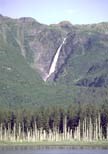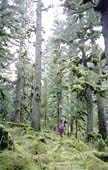 Prince William Sound
Prince William Sound
Prince William Sound, where spilled oil did its greatest damage, is also home to five of the seven most valuable parcels in terms of restoration value. Each available parcel in the spill region was ranked for its value as habitat for injured resources.
Jackpot and Eshamy bays in western Prince William Sound, Bligh Island and Two Moon Bay in the northeastern sound, and Sheep Bay in the eastern sound are all regarded as having exceptionally valuable habitat. Logging was already underway at Two Moon Bay when habitat protection efforts began and other areas were slated for timber harvest.
Under agreements with Chenega Corporation, Tatitlek Corporation, and Eyak Corporation, 204,759 acres were protected, including nearly 600 miles of shoreline and 175 salmon streams. About 40 percent of the total acreage is protected through conservation and timber easements. Chugach National Forest has taken over management of most of the land, with smaller areas set aside for the state to manage as part of the marine park system.
Lower Kenai Peninsula
Two protection packages that received overwhelming public support are located on the Kenai Peninsula. The first occurred in 1993, when the state acquired 23,000 acres within popular Kachemak Bay State Park, across the bay from Homer, to prevent logging of the old-growth maritime forest. The Trustee Council provided $7.5 million for the purchase, and the State of Alaska contributed $7 million from the Exxon criminal settlement and another $7.5 million from its civil settlement with Alyeska Pipeline Service Company.
Alaska contributed $7 million from the Exxon criminal settlement and another $7.5 million from its civil settlement with Alyeska Pipeline Service Company.
In 1997, the Trustees funded the purchase of 32,537 acres within Kenai Fjords National Park and adjacent islands within the Alaska Maritime National Wildlife Refuge. The $14.1 million land package with English Bay Corporation includes some of the most valuable coastal habitat within the park, which is the second most popular park in Alaska, behind Denali National Park and Preserve.
Afognak-Shuyak Islands
Shuyak Island State Park quadrupled in size in 1997 when 26,665 acres protected by the Trustee Council were added to the park along with other state lands. The habitat on Shuyak Island was ranked among the highest in the spill region and is very popular for recreational purposes.
 Afognak Island State Park was created in 1994 after protection of 41,549 acres through the Trustee Council process. This highly productive coastal habitat was threatened by imminent clearcut logging of the mature spruce forest.
Afognak Island State Park was created in 1994 after protection of 41,549 acres through the Trustee Council process. This highly productive coastal habitat was threatened by imminent clearcut logging of the mature spruce forest.
Another 41,350 acres were protected on northern Afognak Island, adjacent to the Kodiak National Wildlife Refuge and Afognak Island State Park. This $70.5 million agreement protects the most highly ranked habitat in the spill region, including large buffers around the popular Paul's and Laura lakes. The extremely high economic value of the timber resources on Afognak Island make protection of this area the most costly in the spill region. The trees valued as good marbled murrelet nesting habitat are also those most highly valued for timber.
More recently, several additional projects were completed on Afognak Island, including the Uyak Thorsheim drainage (1953 acres, completed in 2017), a purchase from Ouzinkie Native Corporation (36,299 acres, completed in 2016), and the purchase of Portage Lake and surrounding lands (5,732 acres, completed in 2018) from Natives of Kodiak. These additional properties provide high-value habitat across the island and offer numerous recreational opportunities.
Kodiak Island
The Trustees have protected 207,256 acres of habitat within the Kodiak National Wildlife Refuge, as well as two more recent protection projects closer to the town of Kodiak, Long Island (1,334 acres) and Termination Point (1,028 acres). Olga Bay, Upper Station lakes, and the Aiulik Peninsula on the southern tip of the island are all considered among the most valuable habitats for injured species. In addition to providing protection for pink and sockeye salmon, harlequin ducks, bald eagles, black oystercatchers, and other injured resources, the Kodiak Island acquisitions also help protect habitat important to Kodiak brown bears.
The Karluk and Sturgeon rivers, among the most productive salmon systems in Alaska, were given temporary protection through a conservation easement that expired in 2014. The terms of the agreement with Koniag Corporation included establishment of a fund that might be tapped for acquisition at some date in the future, but that agreement has since expired.
